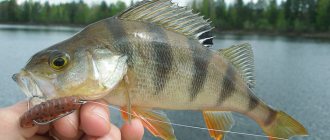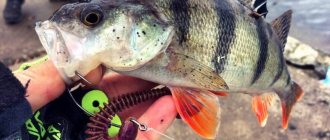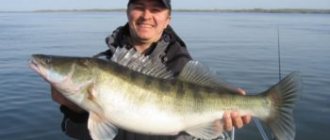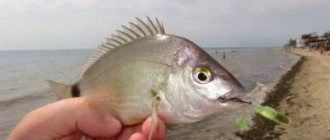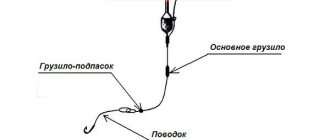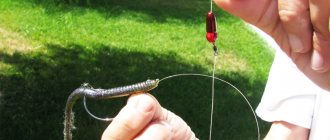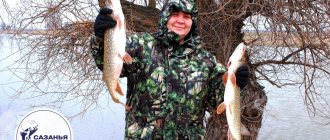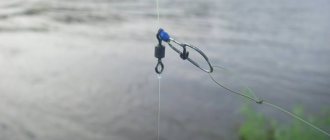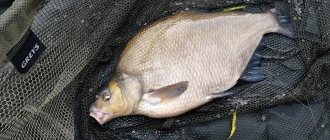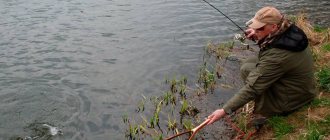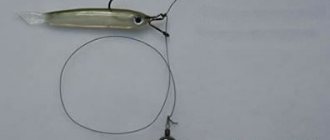A retractable leash is one of the options for spinning equipment, the popularity of which has recently been growing. Some fishermen also call the retractable leash “Moscow rig.”
The principle of the retractable leader is to separate the sinker and the bait, which allows you to catch cautious and shy fish. Various types of bait can be used, but most often silicone baits and sometimes a wobbler are used.
A retractable leash allows you to fish in the bottom layers of water; with its help you can catch perch, pike, pike perch and other fish. A retractable leash works especially well when catching passive fish.
Speaking about the advantages of a retractable leash, we cannot mention its main disadvantage - the retractable leash often gets confused when casting and retrieving the bait.
There are several options for installing a diverter leash; let’s try to consider them in more detail.
Retractable leash with one swivel
The easiest way to install a diverter leash. The swivel is needed to reduce tangling of the fishing line.
The swivel is tied 30-40 cm from the end of the main line; this distance can be changed depending on the fishing conditions. A sinker is tied to the end of the main line; a drop-shaped sinker is best. A leash is tied to the other eye of the swivel, at the end of which a hook with bait is tied. The leash can be made of either monofilament or fluorocarbon.
The main advantage of this installation is its simplicity; the disadvantage is the inability to quickly change the distance between the swivel and the sinker. This installation method can be used if you need to tie a diverter leash directly while fishing.
Types of sinkers
In the tackle, the sinker is one of the key elements and, depending on the fishing conditions, and in particular, the forces of the current, the structure of the bottom, its clutter and the degree of overgrowth with aquatic vegetation, anglers have developed a number of optimal forms of weights that allow comfortable casting and retrieving. We will consider the main forms of sinkers and the conditions for their use in rigs in more detail in the further information provided to the reader.
Bullet
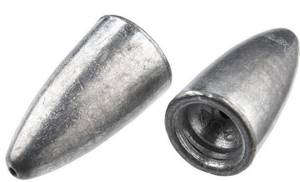
The bullet is one of the most common forms of sinker for spinning fishing equipment. The name speaks for itself about the similarity of the shape and long-range qualities of this type of load with the consumable part for small arms. In addition, the presented type is characterized by a low degree of grip and high cross-country ability on the bottom of the fished reservoir overgrown with fine vegetation. This type of load is suitable for all types of installations with outlets. In rigs, the type is used both with swivels and with a direct connection to the cord.
Drop shot
Types of sinkers specially designed for mounting one of the varieties of spaced equipment of the same name. A distinctive feature of weights when fishing using this type of spinning rigs is the presence of a mounting eye, combined with a swivel, deeply sealed into the body of the weight. This design eliminates the use of additional elements, reduces the possibility of tangling and overlapping of lines during wiring, which makes the tackle more delicate and easier to use.
Tyrolean stick
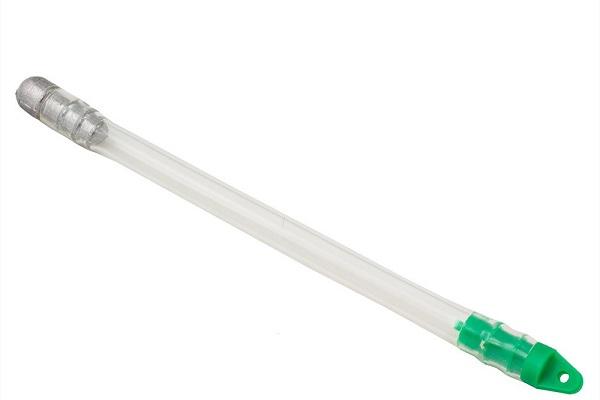
A specially designed sinker with a high degree of maneuverability on a cluttered bottom with sunken branches, snags and a rocky bottom. The Tyrolean stick looks like an elongated cylinder. It can have different diameters and, accordingly, different masses, selected based on the fishing conditions that arise. Has a mounting eye at the end of the cylinder. Disadvantages include low range.
Long
A widely used pear-shaped sinker with an elongated middle part. At the thinner end, the weight has an element for connection with the rest of the equipment. The shape has a high degree of range, but has low cross-country ability and is recommended for use on a relatively clean and hard bottom.
Retractable leash with triple swivel
According to most anglers, this method of installing a diverter leash is the best.
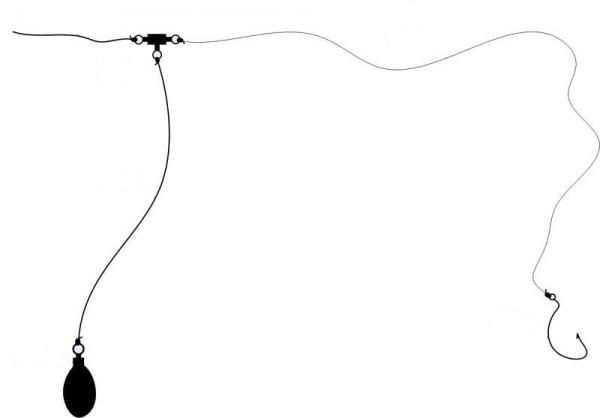
The main advantage of this method is that you can make several versions of a retractable leash at home in advance, with different distances from the swivel to the load and different lengths of the leash, reel them onto a reel, and when fishing, use the option that is better suited to specific fishing conditions.
To make a triple swivel leader, tie the main line to one eye of the triple swivel. Tie a leash with a hook and bait to the other eye, and tie a fishing line with a sinker at the end to the middle eye of the swivel.
Pros and cons of a diverter leash
The use of a diverter leash as equipment has its disadvantages :
- relative complexity of installation, a lot of time for installation and re-equipment of the outlet leash;
- the retrieve speed is significantly lower than when using classic spinning baits, so it is not advisable to use it to search for active fish in unfamiliar places;
- twisting the bait if it is unevenly set on the hook. As a countermeasure, unloading of the hook forearm is used.
- in muddy bottom conditions it does not allow you to control the bait. The cargo falls into the mud.
- using a retractable leash in the presence of grass gives a lot of false signals, hooks, and pulling the bait off the hook.
The undeniable advantages of a retractable leash:
- casting distance;
- successful fight against wind and windage when casting;
- high tactile sensitivity when wiring;
- more natural behavior and attractiveness of unloaded bait in the water, which has a positive effect on the bite of inactive fish;
- allows you to fish a promising fishing spot for a long time and thoroughly.
The use of different options for mounting a retractable leash for catching predatory fish will significantly expand the arsenal of a novice spinning angler and will bring real pleasure from catching fish.
Retractable leash with twin swivels
Swivels of this type are extremely difficult to find on sale. Installation of a diverter leash with paired swivels is similar to installation with a triple swivel.
You may be interested in: Spinning for pike
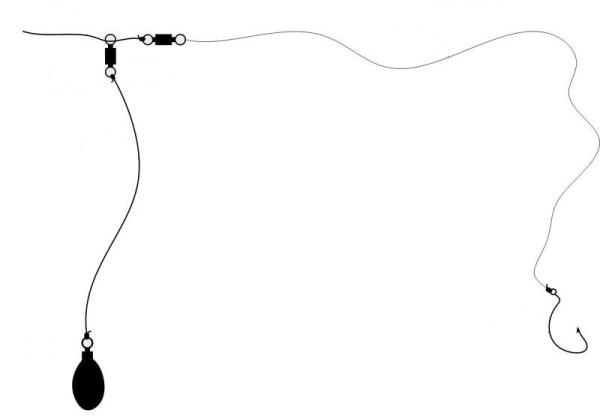
The main line is tied to one eye of the swivel, and a leash with a hook and bait is tied to the other eye. A fishing line with a sinker is tied to the free eye of the paired swivel.
Retractable leash. Installation, equipment - Fisherman's Encyclopedia
The retractable leash has proven its worth in sport fishing and is gaining popularity among amateurs. There are a lot of options for equipment and types of installation of the outlet leash. We need to figure it out. Now I will tell you how to knit a rig with a retractable leash .
You have to knit the lead leash yourself. Here, not everything is as obvious as in a classic spinning rod - tie a jig or spoon and that’s it... You need to correctly assemble the installation from several elements, harmoniously select the equipment for a specific place and fishing conditions. Let's talk about this.
So, some basics. We use a diverter leash in two cases:
A) It is necessary to distribute the weight and small silicone bait to different points so as not to confuse the fish with a huge piece of lead in front of the small silicone bait.
This need often arises when we want to fish with small silicone bait at great depths and/or serious currents. To fully fish in such conditions, you need a heavy jig of 20-30g, sometimes more.
Of course, putting a 2” vibrating tail on such a jig head is a circus! So a spaced installation with a branch lead is used.
B) When you need to fish a steep edge, a drop. A regular jig is not the best solution. The jig passes a steep edge quickly, literally in a matter of seconds, and the bait moves out of the fish’s field of vision... With a retractable jig, we can slowly move the load along the slope, or play the bait almost on the spot. So, the advantages of a retractable leash for catching steep edges are undeniable.
So, what is the installation of a diverter leash? Let's start with the basic elements of the equipment.
Spinning rod for fishing with a retractable leash . A regular jig spinning rod with a fast action. If fishing is carried out from a bank overgrown with bushes and trees or from a boat, it is quite short (up to 2.4 m). If you are fishing on the shore and you need a powerful cast to the far edge, use a longer stick (up to 3m).
The main fishing line when fishing with a diverter is a braided cord. There are no options here. You need the sensitivity of the gear. We must have good control over the movement of the load along the bottom and clearly record bites.
The thickness of the cord is not particularly large. Still, a leash made of relatively weak fishing line or fluorocarbon is used, so the very thick cords that we use in heavy jigs are not in use. Usually around 8-12lb is normal. A relatively thin line gives an advantage in casting distance and does not float as much in the current.
Well, if there is a regular hunt for perch or medium-sized pike perch, that’s one thing. If you come across good pike and pike perch, you should use more powerful tackle, a strong cord, and a fairly thick leash. For regular catfish bites, even add a leash made of thin steel or string to the rig. It is clear.
Sinker for the outlet leash . Usually they use a special weight - a weight with a cast-in swivel. This is ideal, because... This type of load rotates the least. But any weight will do, even a shapeless piece of lead... It’s worth considering only two points: the weight must have loops; and don’t be shy about your weight. It is important to clearly hear the tapping of the bottom with this load.
Load leash . The leash is made from fairly thick fishing line or fluorocarbon (0.3mm or thicker). It is the leash of the load that comes into most contact with the bottom, with snags and shell rock. So, a hard, wear-resistant leash material is just right. Sometimes a double leash is used so that if the shell cuts off one vein, the second one allows you to save the weight.
In addition, a rigid leash is least susceptible to tangling and tangling. The length of the load leash may vary. If we want to fish the very bottom layer, then we take a relatively short leash of weight: 20-50cm. Accordingly, if it makes sense to move the bait higher, then we lengthen the leash. But in most cases they catch it close to the bottom.
The bait leash is made longer than the load leash. Usually this is 1-1.5m to give the bait more freedom. Sometimes shorter, sometimes longer, at the discretion of the angler, based on fishing conditions and ease of casting. The leash material is fishing line or fluorocarbon. For perch, a flur of 0.2-0.25 is usually used. If serious fish are biting, it is better to use a thicker leash.
It is advised to tie the hook to the leash not just with one of the many fishing knots (clinch, palomar, etc.), but so that the hook sits loosely in the loop of the fishing line. For example, use a Rapala knot. This gives additional freedom to the bait.
Bait equipment . With a retractable leash, various silicone baits are used, both active (twisters, vibrotails) and passive (slugs, worms, crustaceans, etc.).
Usually the bait is put on a single or offset hook. On a single hook, the tip is left open only if the fishing is in a familiar place, clear of snags.
Otherwise, the sting is hidden according to the offset principle.
Accessories . For diverting, you can use regular or triple swivels. We take high-quality, reliable, small swivels if possible.
Individual components of the equipment were disassembled. Now let's look at different installation options, layouts of the outlet leash, their advantages and disadvantages.
The first, easiest way to tie a lead leash, without any swivels and other accessories. At the end of the main cord of the spinning rod we tie a weight. And if you intend to change the weight of the weight, we tie a fastener, and we already attach the weight to it.
Above the weight, 20-50 cm, we knit a double loop and attach a leash with bait into it, using the loop-to-loop method. The method is the fastest, knitting on the spot. But, let's face it, it's not ideal. The absence of a swivel leads to frequent tangling and tangling of the leash.
And the weight on the cord is not the optimal solution.
The second option is a little more advanced. Instead of a regular loop, a swivel is tied to the cord, and a leash with bait is attached to it. The advantage is less overlap and tangling. The rest is the same.
Triple swivel mounting. A triple swivel is attached to the end of the cord. A weight leash is tied into the opposite ring (here you can use thick fishing line or fluorocarbon). The bait leash is tied to the central ring. Quite a well balanced montage!
Mounting option with sliding weight. A swivel is attached to the lead of the weight. We put the swivel on the cord. Then, at the end of the cord we knit another swivel. And we already tie a leash with bait to it.
This installation allows you to play the bait more widely. The load restricts her movements less. The bites are clearer.
There is an opinion that it is this installation of the outlet leash that is least susceptible to tangling and tangling.
There are a dozen more variations of diverter installation, more saturated with fittings, swivels, and fasteners. But, I have indicated the four most popular installations, from which everyone can develop their own style and choose a convenient solution.
Source
Source: https://fish-guide.ru/masterskaya/otvodnoj-povodok-montazh-osnastki/
Retractable leash with sliding sinker
The method of installing a retractable leash with a sliding sinker is considered by many fishermen to be the best installation option. Provides maximum sensitivity of the gear, every touch of the fish to the bait is transferred to the main fishing line.
The sliding installation of the diverter leash is done as follows: a swivel is put on the main line with one eye, which slides freely along it. The end of the main line is tied to the second swivel, to the other end of which a leash with a hook and bait is tied. A fishing line with a sinker is tied to the free end of the swivel, which slides along the main line.
Installation of diverter leash | Tips for fishermen
Good day to you, dear readers! In today's article we will talk about installing a diverter leash. There are so many fishermen, so many opinions, options and combinations of this equipment, today I will talk about the main aspects of this type of fishing.
One day, when several fishing trips were unsuccessful, I had to look for new solutions to the problem of lack of bite, and I turned my attention to this wonderful method of fishing.
As they say, everything ingenious is simple, and after making several setups at home, I decided to try this method. Arriving once again at the reservoir, and making sure that the turntables and jigs were not working again, I installed a diverting leash, and at the very first retrieve, I pulled out the perch with the palm of my hand.
I think it’s time to move on to a description of the installation and other subtleties, but first, the general diagram of the Moscow equipment:
As you can see, there is nothing complicated here. You need to tie three loops on a piece of fishing line; if you have forgotten how to do this, use the article on knitting fishing knots.
Installation of equipment
Most anglers advise tying the rig on the main line, but I use a different method. I prepare small (up to a meter) equipment at home, as in feeder fishing , after which I tie everything necessary to it at the reservoir. I tried knitting a breakaway leash on the main braid, but I didn’t notice any difference, except for the loss of time when it breaks.
Since this type of fishing is unpredictable, and sometimes other rig options work better, I will show you the ones I use. Yes, by the way, I knit rigs from fluorocarbon, I don’t know if this affects the bite, but it definitely affects the wear resistance.
It is usually recommended to hang the sinker 30-40 centimeters below the leash, in principle this is what should be done, this will avoid unnecessary hooks.
Option one:
I did not find a specific pattern in the operation of the equipment, but in my opinion, this type of equipment works better. There are no unnecessary parts, and the equipment behaves more naturally, and is also faster and easier to manufacture. Overlapping of this installation does not occur due to the rigidity of fluorocarbon.
The disadvantage of this type of installation is that over time the leash gets twisted and has to be changed.
The second option of equipment is equipment using a swivel
This type of installation is good because the leash does not twist, and in some fishing conditions, this installation works better than the previous one (I don’t know what this is connected with, maybe with the mood of the fish :).
So, to summarize, it should be said that you should have both rigs when fishing, and the greater their number, the longer you will fish, since breakage of gear is not uncommon here.
Leash
Leashes should also be prepared as much as possible, and of various sizes. On fishing sites they recommend a length of 1 meter, but this is more universal than some kind of standard.
Different lengths of rigs work on a reservoir under different conditions.
Once I was fishing with a meter-long leash, there was no bite, then I got hooked and tore off half, but did not put another one, but tied a hook to this piece and began to fish.
On the third retrieve, a bite occurred and a small zander was recovered, from which we can conclude that the length of the leash must be selected experimentally directly on the reservoir.
I recommend preparing leashes from 60 to 120 centimeters and experimenting. I always make 3 of each size, depending on the length of fishing, you can prepare more.
It is better to use regular fishing line, that is, not fluorocarbon. This is due to rigidity. Regular fishing line is softer, and the animation of the bait becomes better and more natural.
In addition, it is not advisable to use fluorocarbon, since the equipment floats in the water column and rarely rubs against stones. If you think that a regular fishing line will be noticeable to the fish, use a thinner leash, because a few years ago there was no fluorocarbon, but there were catches, and not bad ones.
Hook
Opinions on the use of hooks vary greatly among different fishermen. Personally, I use simple hooks, the most important thing is that they fit the size of the silicone.
When fishing with a retractable leash, it is not necessary to fish with silicone; you can successfully use spinners and wobblers, but based on the issue of economy, it is better to use cheap baits.
To be honest, I have never used either wobblers or spinners.
The hooks should only be new and sharp, since the bite is not always noticeable, and the fish has a few seconds to spit out the tasteless bait. I probably didn't discover anything new about the sharpness of hooks, but it was worth mentioning.
When using simple and offset hooks, no difference was noticed, but if you decide to use simple hooks, it is better to choose one with a long shank so that the sting comes out approximately in the center of the bait.
Sinker
The sinker is selected to match the test of the rod; the best option would be a Tyrolean stick, which I wanted to write about in a separate article (I hope to write soon). I use regular pear-shaped weights:
Yes, they often break away, but they fly further and dive faster, which is a definite plus in the current. You can also use ordinary “Cheburashka” weights; they are cheaper than pear-shaped weights and are well suited for beginners.
I would also advise equipping the sinkers with a small loop of fishing line of a smaller diameter than the fishing line of the equipment, so that when hooked, you can save the leash with the bait.
To summarize, we can say that this fishing method will undoubtedly please any spinning angler, especially when there is practically no bite. The most important thing is not to forget to experiment with the leash length and rig options.
I would also like to say that the catch can include not only predatory fish, but also peaceful ones. In general, a diverting leash is an almost universal equipment that does not work except on an asp, and then I think something can be done about it.
In general, I advise both beginners and experienced fans of spinning fishing to take this equipment into use. No tail, no scales, dear fishermen!!!
Source: https://fisherlive.ru/otvodnoj-povodok.html
Lures for diverting leash
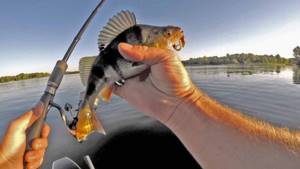
- Silicone baits are the number one bait for a retractable leash, their use allows you to achieve the best results. All types of silicone baits are used: twisters, vibrotails, silicone worms, octopuses, frogs, but the most popular of the silicone baits for retractable leashes is the twister. The twister has two advantages, firstly the large selection of sizes and colors available to choose from, and secondly, the natural, highly active play of the twister when the sinker falls to the bottom.
- The wobbler has a number of advantages over silicone baits when used with a retractable leash. A wobbler attracts fish better from a long distance and a large predator prefers a wobbler to other baits when biting actively. Floating wobblers and suspenders are best suited for use with a retractable leash. Deep diving wobblers should not be used. Most often, inexpensive wobblers are used with a retractable wobbler, which is not such a shame to lose when hooked.
- Rotating and oscillating lures are extremely rarely used with a retractable leash.
Line for diverting leash
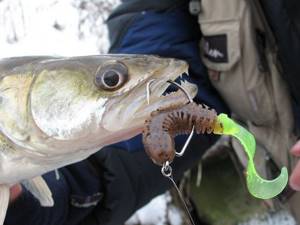
For the main fishing line, it is recommended to use braided fishing line; it provides better sensitivity of the gear. Braided fishing line does not stretch when tensioned and transmits even the lightest touches of the fish to the bait well. The diameter of the main line must correspond to the intended catch and fishing conditions. Beginners are advised to use a larger diameter main line.
The line from the swivel to the sinker should be 30-40 cm long. The length of the line on the lead leash to the bait is about 1 meter, but it can be more or less depending on the fishing conditions. Both of these lines should be thinner than the main line, then when hooked you will lose the sinker or hook with bait, but keep the main line.
Leashes are best made from monofilament or fluorocarbon. It is better to make leashes from fluorocarbon fishing line, since it is less noticeable in the water and wears out less, although it can withstand a lower breaking load. Recommended diameters for leashes: monofilament up to 0.2 mm, fluorocarbon fishing line up to 0.27 mm.
You may be interested in: Shad wobblers
Braided fishing line should not be used for leashes; it is too noticeable in the water and is more likely to get tangled.
Sometimes fishermen do not tie the sinker and hook to the fishing line, but attach them to the fishing line using a fastener; this is done for the convenience of replacing the sinker and bait while fishing.
It is more convenient to knit lead leashes at home, wind them on a reel, and when fishing, simply unwind them from the reel and tie them to the main fishing line.
What is a diverter leash tackle?
The equipment represents a knitting design of spaced mounting of the sinker and bait, where these two components are located perpendicular to each other, therefore, one of the elements of the equipment does not lie on a common axis with the main cord, but is attached to the side. As a rule, in the classic version, the sinker is placed at the end of the main cord, and the selected type of bait on the hook is tied at the required distance upward from the weight for the fishing conditions and mounted to the side in relation to the line of the cord. In practice, the installation scheme may change slightly, supplemented with all sorts of fastening elements and devices that prevent twisting and overlapping of the fishing line, but in general without changing the essence of guiding the bait when retrieving.
Sinkers for diverting leash
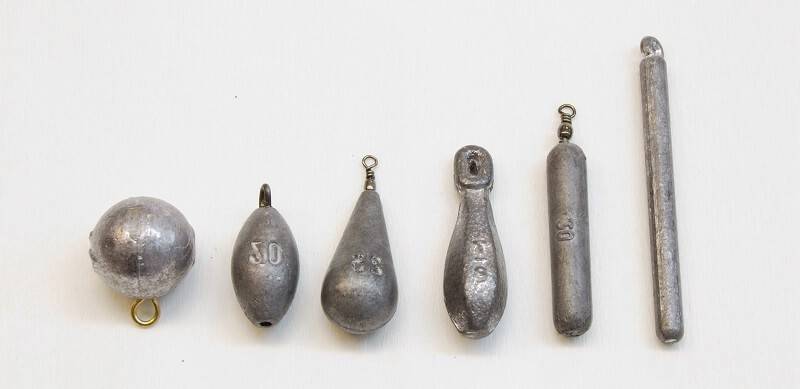
The weight of the lead sinker must correspond to the fishing conditions and depends on the presence and strength of the current, the depth at the fishing site, the nature of the day, the type of fish and its activity. As a rule, the mass of the sinker should be two to three times the mass of the bait. Very often the weight of the cargo is from 15 to 30 grams.
A sinker that is too heavy or too light will significantly reduce fishing efficiency. After falling to the bottom, an ideally weighted sinker should rise from the bottom after 2-3 revolutions of the reel and not drag along it. When fishing in the current, you should use a heavier weight sinker.
According to the shape, sinkers for the outlet leash are divided into three types:
- Ball-shaped ones, also known among fishermen as “Cheburashkas,” are the most widespread. It is better to use such sinkers on a clean bottom; they are not suitable for rocky bottoms; there are often snags on rocks and they collect a lot of filamentous algae. The main advantage is good flight performance.
- The sticks are also known among anglers as "Tyrolean sticks". They are best suited for reservoirs with a rocky bottom, as they are least prone to snags among other species. The disadvantages of stick-shaped sinkers are their poor flight qualities and the difficulty of determining when the sinker touches the bottom.
- Drop-shaped (pear-shaped) - the best shape of sinkers for equipment with a retractable leader, good flight qualities, can be used for fishing on reservoirs with any bottom, as they resist snags well.
Spinning equipment
Recommendations for equipping the rod when installing a retractable leash for beginner spinning anglers:
- To understand the game of bait, you need to use a sensitive, lightweight spinning rod with a fast action.
- When fishing from a boat, use tackle no more than 2.5 m, from the shore - 2.7 m.
- Use a braided fishing line (including when fishing in a current, then for less resistance with water, use a fishing line of small diameter), which is sensitive to any bites. Many anglers use braided line as their main fishing line.
- As a leader material, you can use a monofilament line (a metal leader can also be used), since it has a lower breaking load than the main thread.
- Use a leash for a weight - 20-30 cm, a leash with a hook - 50-150 cm. The diameter of the leash is from 0.16 to 0.2 mm.
- Fishing on a clean bottom involves placing a regular hook with a long shank; on a grassy bottom - an offset hook, a type whose size is selected based on the type of bait used and future prey.
- Swivels and sinkers. The weight of the sinker must be selected based on the characteristics of the reservoir, current, and depth. Typically, weights weighing from 5 to 25 g are attached. The shape of the weight depends on the topography of the reservoir and the speed of the current.
Types of sinkers and their use Bullet - used mainly in Korolin and Texas rigs.
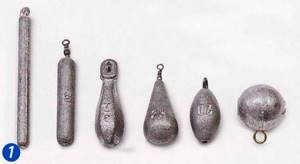
Drop-shot - used in rocky, snagy places.
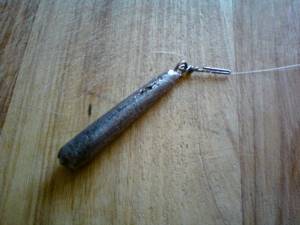
Tyrolean stick - its elongated shape and the presence of air inside make it possible to successfully use such a sinker in particularly snaggy and overgrown places.
Long - often used in drop-shot rigs.
An example of rigging a rod when fishing in still water is described in detail by the author A. Sharai here https://555hf.tv/blog/652
Wiring equipment with a branch lead
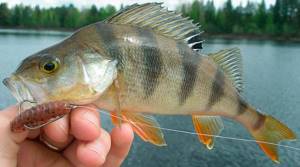
Fishing with a retractable leash allows the spinner to use different leads: stepped, uniform and Stop and Go, but still the main wiring for equipment with a retractable leash is stepped.
When retrieving, a rig with a retractable leash does not drag along the bottom, but goes at a certain distance from the bottom, which makes the bait clearly visible to a predator.
In some cases, dragging the bait along the bottom, as well as hitting the bottom with the sinker, can be effective; in both cases, clouds of turbidity rise from the bottom, which attract the predator to attack the bait.
You may be interested in: Microjig
When retrieving, the tip of the rod should be kept raised up; when the bait approaches the angler, the tip of the rod can be lowered closer to the water. This position of the rod when retrieving allows the sinker to rise higher from the bottom, thereby attracting a predator from a greater distance.
Video
Pike fishing in autumn in the video below:
There is nothing super difficult about fishing with a retractable leash, but it will take some practice. Thanks to this, you can improve jerks in different conditions, attracting the attention of predatory fish with properly selected baits.
Views: 472
Similar articles:
- Carolina equipment for spinning: installation, fishing technique, wiring Until recently, components and equipment for fishing did not allow…
- Drop-shot equipment: what it consists of, installation, fishing technique Among the variety of spinning equipment, this type is considered the most catchy. Thanks to…
- Leashes for pike: types of leashes, optimal length, determining which ones are better Pike is a desired trophy for any angler. Someone purposefully...
- How to choose a spinning rod for catching pike from the shore? Optimal rod length What should be the ideal spinning rod for coastal pike fishing?…
Retractable leash for pike perch
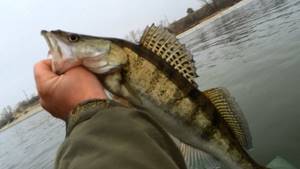
For catching pike perch using a retractable leash, it is best to mount equipment with a triple swivel.
The leash from the swivel to the bait is best made from fluorocarbon fishing line, the diameter of the fishing line should be about 0.3 mm, the length of the leash should be from 70 to 120 cm, depending on the fishing conditions. The length of the fishing line from the swivel to the sinker is from 40 to 70 cm.
The best wiring for catching pike perch on a retractable leash is a stepped wiring, in which the sound of the sinker hitting the bottom is very important.
Coil
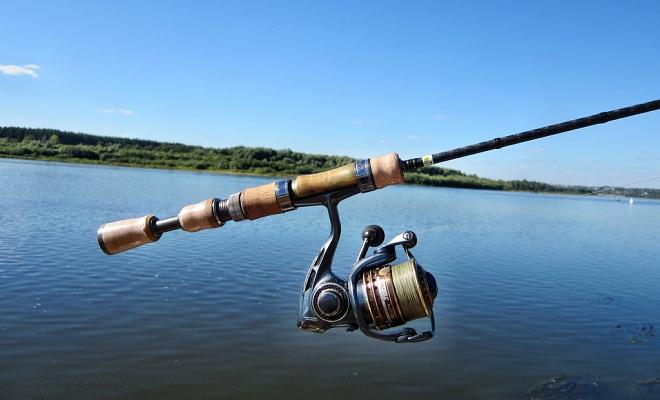
A fishing rod for fishing with a retractable leash is equipped with a spinning reel, although recently many advanced spinning anglers have successfully used multiplier reels with a higher pulling force, but small dimensions and weight. Spool characteristics from 1500 to 3500 units are almost always enough for comfortable fishing. An important attribute of the mechanism is the presence of a finely adjustable friction clutch. A gear ratio of 1/5 covers the needs for implementing various styles of wiring on windings.
Retractable leash for perch
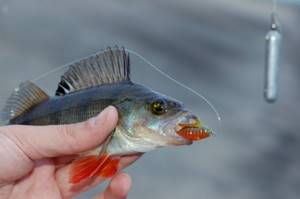
Perch is a medium-sized fish; it is very important for the angler to feel even the slightest touch of the perch on the bait. The sliding mounting of the lead has the best sensitivity, which is why it is best suited for catching perch.
The leash from the swivel to the bait is best made from fluorocarbon fishing line; the diameter of the fishing line can be from 0.2 to 0.4 mm. The length of the leash can be made shorter; lengths from 35 to 70 cm will be sufficient in most cases. The weight of the sinker can be from 3 to 10 grams.
The bait when catching perch on a retractable leash can be any silicone bait: twister, vibrotail, octopus, silicone crustacean.
Installation of a diversion leash - quickly and with results on a pond
A retractable leash is a type of equipment that has been used by our fishermen for quite a long time.
True, it attracted special attention simultaneously with the popularization of ultralight fishing, and this is not surprising.
Here’s what I think: “You can fish with a retractable leash without a super-sensitive rod, but the real “buzz” from fishing with this tackle and with light baits.”
If you are still interested, then this article is for you and it will tell you how to make and use this rig.
Installation and equipment of the outlet leash
As they say, “ there are so many fishermen, so many opinions . We invite you to consider 2 types of installation and equipment of the outlet leash or, as it is also called, Moscow equipment. There should be enough information to get started.
Retractable leash for pike perch
Since the retractable leash allows the baits to play freely, this is precisely why it very much attracts the attention of the pike perch. Many pike perch fishermen use the following setup:
- We will need a jig bait or sinker, and a barb (with foam).
- We attach a triple swivel to the main fishing line (cord), so that one ear extends at 90°.
- We attach a leash 70-120cm long to this ear. (it is advisable to use fluorocarbon line Ø 0.3-0.4).
- We tie a barb or other light bait onto the fishing line.
- On the third ear of the swivel we attach a leash 50-70 cm long, from the same fishing line. You can attach both a jig bait and a sinker of the desired weight to it.
Retractable leash for perch
Since perch is smaller than pike perch, installation should be more delicate .
For installation we will need:
- 2 carbines
- sinker 3-10g (preferably cylindrical),
- leash (fluorocarbon Ø 0.2-0.4),
- silicone
Let's start installation
- We pass one of the swivels onto the main line ; it should slide freely along it.
- the second swivel to the main fishing line (cord).
- Through the sliding swivel (unoccupied ear) we pass a piece of fishing line 20-30cm.
(the quality of the fishing line does not matter; when hooked, it should break faster than any other part of the equipment) we also pass a sinker onto this fishing line (it should slide along the fishing line). - Now you can tie the two ends of this fishing line with a triple regular knot. We should have a loop that connects the swivel and the sinker.
- Now let's go back to the swivel tied to the main line. We tie a leash (30-70cm) to the free eye and attach the silicone equipment to it with an offset hook.
- You can hang a shot on the hook if you are fishing in the current to lower the bait to the bottom.
The equipment is made in such a way that when biting it is transferred directly to the tip of the rod. In this case, the fish will not feel the weight of the load, since it is made to slide . Well, the tackle is ready - into battle.
How to fish with a retractable leash
Fishing with a retractable leash attracts with its dynamism and sensations when biting and landing fish.
To fish with this tackle we need a spinning rod. If we catch pike perch, then with a test in the aisles of 10-30 grams, and if you plan to catch perch on a retractable leash - a test from 0-10 grams. Naturally, the cord also needs to be selected according to the weight of your bait.
is that you knock a weight on the bottom, a predator reacts to this branch, sees your bait and attacks it. When fishing, they use stepped wiring, which adds a certain charm to the performance of your bait.
Source: https://www.oster-vip.com.ua/news/otvodnoj-povodok.html
How to make a diverter leash for pike
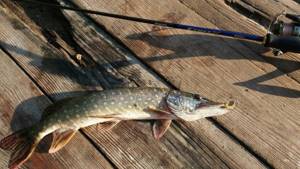
When fishing for pike with a retractable leash, you must always place a metal leash in front of the bait. Pike has powerful jaws and sharp teeth, with which it can easily bite through any fishing line. The length of the metal leash can vary and is usually 15-20 cm.
For catching pike on a retractable leash, a rig with a triple swivel is best suited. Pay special attention to the quality of the swivel; you may catch a large pike, and it will be very disappointing to be left without a trophy due to the breakdown of a low-quality swivel.

Fishing for pike with a retractable leash allows you to catch this predator in deep places, lifting the fish from the very bottom. Often, when catching pike on a retractable leash, you come across truly trophy specimens.
